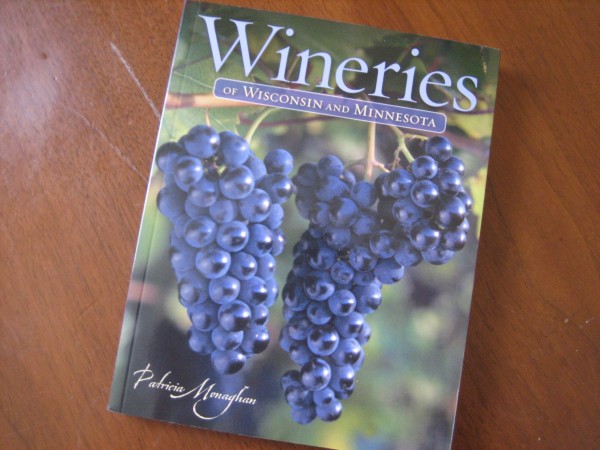
Patricia Monaghan submitted her proposal on a Monday and had a book contract on Wednesday. Her idea was simple; create the most comprehensive guide to the wineries of Minnesota and Wisconsin. After a year of work and over 6,000 miles on her car, last summer Monaghan published Wineries of Wisconsin and Minnesota (Minnesota Historical Society), the first comprehensive guide to the new and emerging wine industry in Wisconsin and Minnesota.
The book is divided into 10 regions, separating the terroir of The Driftless Area of Wisconsin from the terroir of Door County, etc. Each section is prefaced with a map and a description of the area. Monaghan writes, “central Wisconsin means hardworking land farmed by hardworking people. Its towns are not lined with antique malls and B and Bs but with hardware stores and feed mills.” She paints a picture of the area and defines the personality of the landscape. “Wine is the integrating of arts, science, and culture,” says Monaghan.

Her book is more than a guide book, it’s a story of the evolution of an industry. Monaghan shares the story of each winery and how it came to be. She writes about Marion Weglarz of Weggy Winery: “Weglarz found himself headed to La Crosse for a business meeting. On a whim, instead of taking the interstate, he drove up Highway 14. There he had another revelation: he had never known that such a lovely hill country could be found in the Midwest.”
Sidebars litter the book, giving the reader interesting facts about the tobacco industry in Wisconsin and the importance of having rocky soil for growing grapes. “Most say that ancient brides and grooms were provided enough mead to keep them drunk for a month,” says Monaghan in her sidebar Bees and Wine located below the description of WineHaven Winery and Vineyard.
Monaghan’s book has brought together the industry while expanding her own understanding of wine. “I had many prejudices against fruit wines and meads when I started the book,” says Monaghan. After tasting the mead at White Winter Winery and many fruit wines made from apples, rhubarb, and a variety of other fruits, Monaghan’s view has changed.
“I am particularly impressed with the people cultivating and growing the grapes”, says Monaghan. In Minnesota the laws and regulations are more strict than those of Wisconsin. In Minnesota 51% of the grapes used to make wine must be Minnesota grown. Monaghan says that these regulations have have pushed an industry to create a taste that you cannot find in California or France. In Wisconsin wine makers can purchase juice from around the world or purchase wine already made and relabel it. Regardless, some wine makers in Wisconsin like Bob Starks and Loren Cade of Vernon Vineyards continue to work with cold hardy grapes like Edelweiss and St. Pepin to create wines with distinct characteristics of the Wisconsin terroir. Monaghan says that Starks and Cade plan to grow the Marquette grape released in 2007 by the University of Minnesota.
Since the book was published two new wineries have popped up in Minnesota and one in Wisconsin. In two years, Monaghan plans to update the book introducing these three wineries and others. She predicts that there will be 10 new wineries across the two states by the time she makes the update. The book will continue to evolve as Monaghan learns of more wineries and perfects her skill of pruning her own vines.
